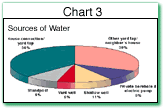|
|
| |
|
|
|
|
|
|

Exploring Chart 3
2. Think about the sources of water listed above. 3. The table below shows the average consumption and cost of safe water for the people of Maputo. Use the information from
the table to answer the questions below.
1.
a. Which of the sources of watershown in Chart 3 bring water directly to a person’s home or yard? b. What percentage of the people get their water from these sources? c. Which sources of water require people to leave their homes or yards to get water? d. What total percentage of the people get their water from these sources?
Enter your answer in the space
below:
Suggested answer:
a.
What might be some drawbacks to having to leave your home or yard to get water for your everyday needs?
Enter your answer in the space
below:
Suggested answer:
b.
Bearing these difficulties in mind, who would you expect to use more water, people with sources of water in their home or yard, or people who have to fetch it from some place else? Explain.
Enter your answer in the space
below:
Suggested answer:
|
Drinking water |
Average consumption |
Average cost |
|
House connection |
17.6 |
1,341 |
|
Other sources |
4 |
3,751 |
*Mts. is the abbreviation for Mozambique’s currency, the metical.
| a. | Who uses more drinking water, people with house connections or others? How many times more water do they use than others? | |
| Enter your answer in the space below: | Suggested answer: | |
| b. | Who pays less per unit for their water, people with house connections or others? | |
| Enter your answer in the space below: | Suggested answer: | |
| c. | Based on your answers to questions 3a and 3b, make a general statement describing the relationships among water cost, convenience, and consumption. | |
| Enter your answer in the space below: | Suggested answer: | |
| d. | If people without house connections are consuming water at a rate below the World Health Organization's recommended daily minimum of 20 liters per person, what changes might you expect to see if they were connected to the piped water system? | |
| Enter your answer in the space below: | Suggested answer: | |
| e. | How do people in your community get their water? | |
| Enter your answer in the space below: | Suggested answer: | |
| Copyright © 1998 IBRD/The World Bank |
[email protected] |